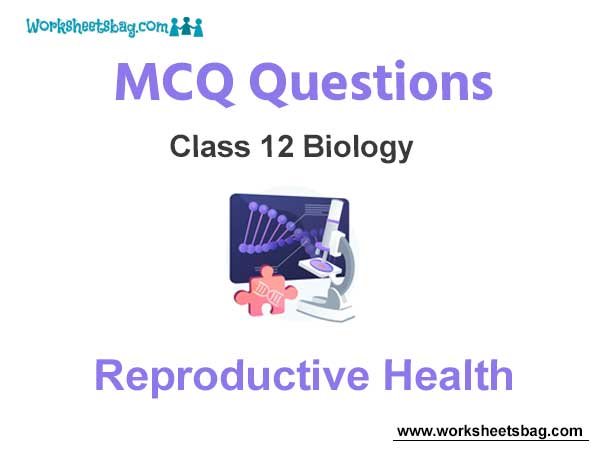Please refer to Reproductive Health MCQ Questions Class 12 Biology below. These MCQ questions for Class 12 Biology with answers have been designed as per the latest NCERT, CBSE books, and syllabus issued for the current academic year. These objective questions for Reproductive Health will help you to prepare for the exams and get more marks.
Reproductive Health MCQ Questions Class 12 Biology
Please see solved MCQ Questions for Reproductive Health in Class 12 Biology. All questions and answers have been prepared by expert faculty of standard 12 based on the latest examination guidelines.
MCQ Questions Class 12 Biology Reproductive Health
Question- Hepatitis B and AIDS spread through
(a) Sharing of injection needles and surgical instruments with infected person
(b) Infected mother to foetus
(c) Transfusion of blood
(d) All of these
Answer
D
Question– Late detection and improper treatment of STDs leads to
(a) Pelvic inflammatory diseases
(b) Abortions, still birth, ectopic pregnancies
(c) Infertility or cancer of reproductive tract
(d) All of these
Answer
D
Question– To remain protected from STDs
(a) Avoid sex with unknown partners/multiple partners
(b) Always use condoms during coitus
(c) Get medical help as soon as person gets doubt of having STD
(d) All of these
Answer
D
Question– Couples having problem in having children could be assisted through which of the following techniques?
(a) Vasectomy
(b) Tubectomy
(c) Assisted reproductive technology
(d) MTP
Answer
C
Question– IVF stands for
(a) Intra vaginal fertilisation
(b) In vitro fertilisation
(c) In viable fertilisation
(d) None of these
Answer
B
Question– Which of the following is/are a part of IVF?
(a) ZIFT
(b) IUT
(c) Al
(d) All of these
Answer
D
Question– In which of the following techniques sperm is directly injected into cytoplasm of ovum and embryo is formed
(a) ICSI
(b) IUI
(c) IUT
(d) GIFT
Answer
A
Question– IUI stands for
(a) Inter Uterine Insemination
(b) Intra Uterine Internalisation
(c) Intra Uterine Insemination
(d) None of these
Answer
C
Question– ICSI stands for
(a) Inter Cytoplasmic Sperm Insemination
(b) Intra Cytoplasmic Sperm Injection
(c) Intra Cervical Sperm Injection
(d) Inter Cytoplasmic Sperm Injection
Answer
B
Question- What is arnniocentesis?
I. Aprernatal, foetal determination test.
II. A postnatal foetal determination test
III. It is based on the chfomosomal pattern of the amniotic flgid.
IV. It is based on the chromosomal pattern of the chorionic fluid.
V. It is based on the chromosomal pattern of the amniotic fluid and the seminal fluid
(a) jJUII
(b) l,V
(c) 1,111
(d) l, IV
Answer
C
Question- For delaying pregnancy or spacing children the ideal contraceptive is
(a) Vasectomy
(b) Tubectomy
(c) IUD
(d) Oral contraceptive
Answer
C
Question- What is the full form of RCH?
(a) Reproductive and Child Health Gare
(b) Reproduction, Oontraqeption and Health
(c) Reproduction and Child Health
(d) Wone
Answer
A
Question- What is false for GIFT?
(a) It is Gamete Intra-Fallopian Transfer
(b) Ovum from a donor is transferred into the oviduct of the recipient
(c) Zygote from a donor is transferred intoihe oviduct of the recipient
(d) The recipient cannot produce ovum
Answer
C
Question- The family planning programme in India were initiated in
(a) 1951
(b) 1961
(c) 1971
(d) 1981
Answer
A
Question- Select the statement(s) that relate to reproductive health-
(a) Healthy reproductive organs with normal functions
(b) Emotional aspects of reproduction
(c) Social aspects of reproduction
(d) AII
Answer
D
Question- What is true for I UDs?
I. They are self-inserted
II. They are inserted by expert nurses
III. They may be non-medicated lUDs, copper releasing lUDs or hormone releasing lUDs.
IV. They are the one of the most widely accepted contraceptives in India.
V. They are inter-uterine devices
(a) All
(b) II, III, IV
(c) I, II, III
(d) I, II, III, V
Answer
B
Question- The diaphragm, cervical cap and vaults are
(a) Disposable contraceptive devices
(b) Reusable contraceptives
(c) lUDs
(d) implants
Answer
B
Question- Which of the following is hormone-releasing IUD?
(a) LNG-20
(b) Multiload 375
(c) Lippes Loop
(d) Cu7
Answer
A
Question- Artifical insemination means
(a) Transfer of sperms of husband to a test tube containing ova
(b) Artifical introductionof sperms of a healthy donor into the vagina
(c) Introduction of sperms of healthy donor directly into the ovary
(d) Transfer of sperms of a healthy donor to a test tube containing ova
Answer
B
Question- On which days of the menstrual cycle is ovulation expected?
(a) 10th – 30th
(b) 1 st -10th
(c) 10th -17th
(d) 18th – 25th
Answer
C
Question- To avoid transmission of STDs –
I. Avoid sex with multiple partners.
II. Always have unprotected sex.
III. Use condoms during coitus.
IV. Avoid sex with unknown partners
V. Avoid sharing of needles
(a) All
(b) I, III, IV, V
(c) I, II, III
(d) I, II, IV
Answer
B
Question- Pills, implants and lUDs are very effective if taken within ______
(a) 5 days
(b) 72 hours
(c) 30 days
(d) 15 days
Answer
B
Question- Present increase in India’s population has not been due to decline in
(a) Infant mort ty rate
(b) Number of people reaching reproductive age
(c) Death rate
(d) Meternal mort ty rate
Answer
B
Question- Diaphragms, cervical caps and vaults are-
(a) For females only
(b) For males only
(c) For males and females
(d) None
Answer
A
Question- Wnere was “Saheli” developed?
(a) Indian Council of Medical Researcn, New Delhi
(b) Central Drug Research Institute, Lucknow
(c) All India Institute of Medical Sciences, New Delhi
(d) None
Answer
B
Question- Nirodh is a popular brand of-
(a) Contraceptive pill
(b) Condom
(c) IUD
(d) Diaphragm
Answer
B
Question- India’s population crossed I billion in
(a) May2001
(b) Dec. 1999
(c) May 2000
(d) Dec. 1991
Answer
D
Question- What is true of natural methods of contraception?
(a) They increase phagocytosis of sperms
(b) They employ barriers to prevent fertilisation
(c) They are natural ways of avoiding chances of fertilisation
(d) They are surgical methods and are terminal methods
Answer
C
Question- What is true for an ideal contraceptive?
I. It should be user-friendly
II. It should be easily available
III. It should be ineffective and reversible with least side effects
IV It should be effective and reversible with least side effects.
V. It should interfere with the sexual act of the user
(a) All
(b) I, II, HI
(c) I, II, IV
(dJ I.II.IV.V
Answer
C
Question- One of the legal methods of birth control is-
(a) By abstaining from coitus from day 10 to 17 of the menstrual cycle
(b) By having coitus at the time of day break
(c) By a premature ejaculation during coitus
(d) Abortion by taking an appropriate medicine
Answer
D
Question- What is the marriageable age for the females and males in India?
(a) 18,18
(b) 18,25
(c) 21,18
(d) 18,21
Answer
D
Question- MTPs are considered relatively safe during the. ____trimester; __________ trimester abortions are much riskier.
(a) First, second
(b) Second, first
(c) Third, first
(d) Third, second
Answer
A
Question- I. Rapid decline in death rate.
II. Rapid increase in MMR and IMR
III. Rapid decline in MMR and IMR
IV. Increase in number of people in the reproductive age group
V. Rapid increase in the death rate
What are the causes of higher population growth?
(A) All
(b) I, II, IV
(c) I, III, IV
(d) lll, IV.V
Answer
C
Question- RCH stands for
(a) Routine check-up of health
(b) Reproduction cum hygiene
(c) Reversible contraceptive hazards
(d) Reproduction and child health care
Answer
D
Question- What is the approximate world population according to the recent census?
(a) About 6 billion
(b) About 60 billion
(c) About 16 billion
(d) About 6 million
Answer
A
Question- When were family planning programmes initiated iff-ftidte?
(a) 1&48
(b) 1962
(c) 4959
(d) 1951
Answer
D
Question- Which of the sets of diseases are completely curable if detected early?
(a) Hepatitis – B, Gonorrhoea, Syphilis
(b) Genital herpes, Chlamydiasis, Syphilis
(c) HIV Infections, Chlamydiasis, Gonorrhoea
(d) Chlamydiasis, Genital warts, Syphilis
Answer
D
Question-Choose the correct option –
I. RTI – Reproductive Tract Infections
II. VD-Venereal Diseases
III. STD – Sexually Transmitted Diseases
IV. IVF – Intra Vaginal Transfer
(a) All
(b) I, II, III
(c) II, III
(d) l,ll
Answer
B
Question- MTP is practised mainly to –
(a) Get rid of unwanted female child legally
(b) Get rid of unwanted pregnancies due to failure of contraception or rapes
(c) Both a and b
(d) Decrease population size
Answer
B
Question-. Identify the true statements from the below statements –
I. There are many side effects of tubectomy and vasectomy.
II. Purpose of tubectomy is to prevent egg formation.
III. The most important component of the oral contraceptive pills is progesterone.
IV. Contraceptive oral pills help in birth control by preventing ovulation.
V. Genital warts is a sexually transmitted disease caused by herpes virus.
VI. In India, there is rapid decline in mfant mort ty rate and MMR.
(a) I, II and III
(b) I, II and V
(c) III, IV and VI
(d) IV, V and VI
Answer
C
Question- MTP was leg sed in India in –
(a) 1971
(b) 1951
(c) 1981
(d) 1923
Answer
A
Question- Sterilisation in males is_______and in females is _______
(a) Vasectomy, Tubectomy
(b) Tubectomy, Vasectomy
(c) Vasectomy, Vasectomy
(d) Tubectomy, Tubectomy
Answer
A
Question- The copper ions of I UDs
(a) Suppress the motility and fertilization capacity of sperms
(b) Make the uterus unsuitable for implantation
(c) Increase phagocytosis of sperms
(d) Make cervix hostile to sperms
Answer
A
Question- What is true for surgical methods?
I. Also called sterilisation
II. Terminal method of contraception
III. Block gamete transport
IV. Called vasectomy in females and tubectomy in males
V. High reversibility and contraceptive efficiency
VI. High contraceptive efficiency
(a) I, II, III, VI
(b) I, II, III, V
(c) 1,11,111, IV, VI
(d) I, II, III, VI
Answer
A
Question- What is the approximate Indian population according to the recent census (May 2000)?
(a) About 1 billion
(b) About 1 million
(c) About 10 billion
(d) About 15 million
Answer
A
Question- What is true about “Saheli”?
I. Developed at the CDRI, Lucknow
II. Contains a steroidal preparation
III. “Once-a-week” pill
IV. Many side effects
V. High contraceptive value
VI. Very few side effects
VII. Low contraceptive value
(a) I, II, III, V, VI
(b) I, III, V, VI
(c) I, II, III, IV, V
(d) I, III, IV, V
Answer
B
Question- Pills –
I. Inhibit ovulation and implantation
II. Alter the qu ty of cervical mucus to prevent or retard the entry of sperms
!!!. Prevent the ejaculated semen from entering the female vagina
IV Inhibit spermatogenesis
(a) All
(b) I, II, Ml
(c) l, II
(d) 1,111,1V
Answer
C
Question- Surgical methods of contraception prevent –
(a) Gamete formation
(b) Gameter motility
(c) Both a and b
(d) Spermatogenesis only
Answer
C
Question- Condoms are barriers that cover-
(a) Penis in male and ovary in female
(b) Penis in male and cervix and vagina in female
(c) Scrotum in male and cervix and vagina in female
(d) Cervix in male and vagina in female
Answer
B
Question- State which is true –
I. Abortions could happen spontaneously too.
II. Infertility is the inability to produce viable offsprings due to defects in the female partner only
III. Complete lactation could help in contraception
IV. Creating awareness can help create a reproductively healthy society
(a) I, III, IV
(b) I, II, III
(c) II, III
(d) III, IV
Answer
A
Question- I. Male condoms are disposable, female condoms are not.
II. Male and female condoms, both, are disposable.
III. Condoms are not disposable in general
IV. Condoms cannot be self – inserted
What is true from the above statements?
(a) I, IV
(b) III, IV
(c) Only II
(d) AII
Answer
C
Question- What is the full form of lUDs?
(a) Inter Uterine Devices
(b) Intra Uterine Diseases
(c) Intra Uterine Devices
(d) Inter Uterine Diseases
Answer
B
Question- STDsleadto-
(a) Itching, fluid discharge, slight pain, swellings, etc.
(b) Pelvic Inflammatory Diseases (PID), ectopic pregnancies, still births, infertility, abortions, etc.
(c) Both a and b
(d) None
Answer
C
Question- Which of the following cannot be detected in a developing fetus by amniocentesis?
(a) Down’s syndrome
(b) Jaundice
(c) Klinefelter’s syndrome
(d) Sex of the fetus
Answer
B
Question- What was the growth rate according to the 2001 census report?
(a) 1.7%
(b) 3.6%
(c) 5:2%
(d) 0.5%
Answer
A
Question- Using which contraceptive also provides protection from contracting STDs and AIDs?
(a) Diaphragms
(b) Spermicidal foams
(c) Condoms
(d) lactational amenorrhoea
Answer
C
Question- Which of the following is a correct statement?
(a) IUDs once inserted need not be replaced.
(b) IUDs are generally inserted by the user herself.
(c) IUDs increase phagocytosis of sperms in the uterus.
(d) IUDs suppress gametogenesis.
Answer
C
Question- MTP is –
(a) Medical Termination of Pregnancy
(b) Also called induced abortion
(c) Both a and b
(d) Aimed at decreasing population size
Answer
C
Question- Diaphragms, cervical caps and vaults are –
(a) Reusable
(b) Non-reusable
(c) Reusable for males only
(d) None
Answer
D


